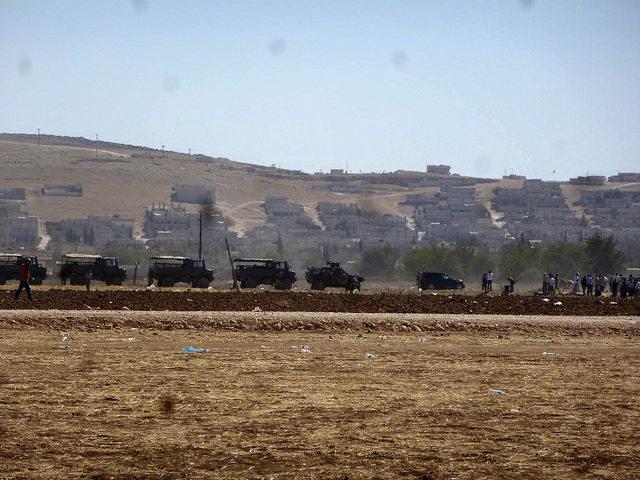IS strategy and Kobani
Posted By Peter Jennings on February 5, 2015 @ 06:00
 [1]After five months of coalition airstrikes and ferocious house-to-house fighting by Kurdish militia, Islamic State (IS) fighters have been pushed out of Kobani on the Syria–Turkey border. Long abandoned by its residents, the town is now little more than booby-trapped rubble. The US military claims that over 2,000 IS fighters have been killed—a remarkable figure considering that the group was numbered at around 6,000 in total when it routed the Iraqi military in the middle of 2014.
[1]After five months of coalition airstrikes and ferocious house-to-house fighting by Kurdish militia, Islamic State (IS) fighters have been pushed out of Kobani on the Syria–Turkey border. Long abandoned by its residents, the town is now little more than booby-trapped rubble. The US military claims that over 2,000 IS fighters have been killed—a remarkable figure considering that the group was numbered at around 6,000 in total when it routed the Iraqi military in the middle of 2014.
Any setback handed out to IS is welcome. Coalition airstrikes around Kobani became more effective when Kurdish ground forces could direct them onto targets. But IS has shown a unique capacity to move from terrorist insurgency tactics to conventional ground operations. Notwithstanding their casualties, IS has said it’ll attack Kobani again. So what makes the ruins of Kobani so valuable to the Islamic State? Four key factors stand out as likely pointers to IS strategic thinking. Understanding the IS leaders’ motivations will ultimately help defeat them.
Behind every IS leadership decision is an insatiable desire for propaganda, which has been consistently fed by the battle for Kobani. International media coverage from the Turkish side of the border has shown coalition airstrikes in real time and tracked the movement of refugees away from the battlefield. IS has invested substantial effort in covering their side of the fight using a captured British journalist ‘reporting’ in Kobani and through social media posted from the battle lines. To some audiences and in particular to many Sunnis, the Islamic State presents itself as fighting for what it sees as a noble cause: establishing a Caliphate to return Islam to a righteous position of global power. Propaganda showing IS taking the fight to ‘apostate’ Shia and Kurds and against ‘corrupt’ Middle Eastern regimes and their Western backers plays well to many in the Sunni Arab street.
From such saturation media coverage comes recruitment: of fighters, women to marry fighters and bear children for the Caliphate, and financial backers. In early February, Defence Minister Kevin Andrews told the Australian media that IS was estimated to have 31,500 fighters [2]—a five-fold increase since last June. In the ruthless calculations of IS leaders, their Kobani losses are acceptable as long as they promote even faster recruitment.
Kobani offered another valuable objective for IS: the ability to weaken Syria and Iraq as national entities by inspiring separatist responses from Kurds and, elsewhere in the south, from Shiites. A Kurdish response to defend Kobani has created a stronger pan-Kurdish identity across Turkey, Syria and Iraq. A line drawn from Kobani through to Mosul would in effect consolidate a Kurdish entity in the north and the Sunni Caliphate to the south. In Iraq, IS is doing its best to encourage Sunni support in the areas it controls and only gains more support when the Iranians train and equip Shia militias to attack Sunni IS strongholds. Kobani isn’t simply a piece of geography, but it sharpens sectarian divides.
The potential for Sunni support of IS on the street in Turkey, Jordan and Saudi Arabia makes it harder for those countries actively to participate in the coalition. The Islamic State’s recent use of a Japanese journalist and a Jordanian military pilot as hostages is clearly designed to threaten coalition unity. Offering these hostages in a swap for a female Jordanian, jailed after a 2005 failed suicide bombing in Amman offered a potential propaganda victory for IS because the woman was associated with al-Qaeda in Iraq, IS’ parent organisation. The unspeakable killings of both hostages are designed to raise the costs, particularly for Arab states, in being part of the coalition.
Finally, the battle for Kobani helps reinforce IS’ goal to be treated as a state. IS fights like a state with forces attempting conventional battlefield tactics. In its brutal way, it’s attempting to administer towns like Raqqa and Mosul by collecting rubbish, re-opening universities and building markets. Its propaganda mimics the media practice of states. All those actions aim to make the case that IS has transitioned from a terror group to a state. That perception matters hugely to IS leaders and it should matter to us too, because in a region of power vacuums, any source of organisational competence will take on the trappings of authority.
The IS defeat in Kobani is an important coalition tactical gain, but it should also be clear that IS’ strategic interests are advanced as much by the appearance of the fight as by the military objective to take the town. IS fought over Kobani for the saturation media coverage; to promote a massive recruitment campaign; to split its enemies and define its boundaries; and to assume the trappings of a war-fighting state. The value of Kobani as a symbol suggests that IS forces will try to take it again, or indeed apply the same strategy in other locations.
Peter Jennings [3] is executive director of ASPI. Image courtesy Flickr user Fraktion DIE LINKE [4].
Article printed from The Strategist: https://aspistrategist.ru
URL to article: /is-strategy-and-kobani/
URLs in this post:
[1] Image: https://aspistrategist.ru/wp-content/uploads/2015/02/15308396496_a0b2082ae6_z.jpg
[2] told the Australian media that IS was estimated to have 31,500 fighters: http://www.heraldsun.com.au/news/brides-of-jihad-bullets-and-burqas-a-chilling-mix-as-islamic-state-sisters-go-ballistic/story-fni0fiyv-1227205647177
[3] Peter Jennings: https://www.aspistrategist.ru/about-aspi/aspi-staff/executive/peter-jennings
[4] Fraktion DIE LINKE: https://www.flickr.com/photos/linksfraktion/15308396496
Click here to print.